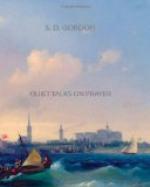A second stage of this wide reading is fitting together the parts. You know the arrangement of our Bible is not chronological wholly, but topical. The Western mind is almost a slave to chronological order. But the Oriental was not so disturbed. For example, open your Bible to the close of Esther, and again at the close of Malachi. This from Genesis to Esther we all know is the historical section: and this second section the poetical and prophetical section. There is some history in the prophecy, and some prophecy and poetry in the historical part. But in the main this first is historical, and this second poetry and prophecy. These two parts belong together. This first section was not written, and then this second. The second belongs in between the leaves of the first. It was taken out and put by itself because the arrangement of the whole Book is topical rather than chronological.
Now the second stage of wide reading is this: fit these parts together. Fit the poetry and the prophecy into the history. Do it on your own account, as though it had never been done. It has been done much better than you will do it. And you will make some mistakes. You can check those up afterwards by some of the scholarly books. And you cannot tell where some parts belong. But meanwhile the thing to note is this: you are absorbing the Book. It is becoming a part of you, bone of your bone, and flesh of your flesh, mentally, and spiritually. You are drinking in its spirit in huge draughts. There is coming a new vision of God, which will transform radically the reverent student. In it all seek to acquire the historical sense. That is, put yourself back and see what this thing, or this, meant to these men, as it was first spoken, under these immediate circumstances.
And so push on into the New Testament. Do not try so much to fit the four gospels into one connected story, dovetailing all the parts; but try rather to get a clear grasp of Jesus’ movements those few years as told by these four men. Fit Paul’s letters into the book of Acts, the best you can. The best book to help in checking up here is Conybeare and Howson’s “Life and Letters of St. Paul.” That may well be one of the books in your collection.
You see at once that this is a method not for a month, nor for a year, but for years. The topical and textual study grow naturally out of it. And meanwhile you are getting an intelligent grasp of this wondrous classic, you are absorbing the finest literature in the English tongue, and infinitely better yet, you are breathing into your very being a new, deep, broad, tender conception of God.
A Mirror Held up to God’s Face.
It is simply fascinating too, to find what light floods these pages as they are read back in their historical setting, so far as that is possible. For example turn to the third Psalm, fifth verse,
“I laid me down and
slept;
I awaked; for the Lord sustaineth
me.”




